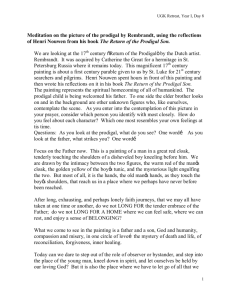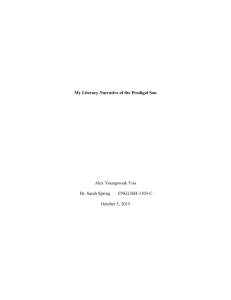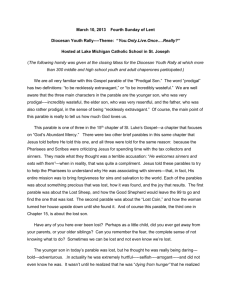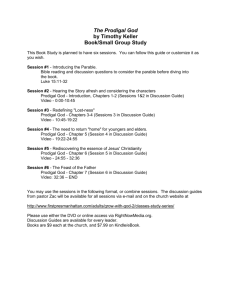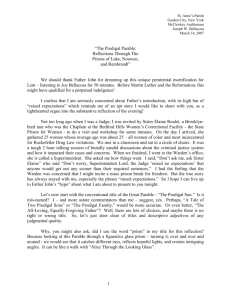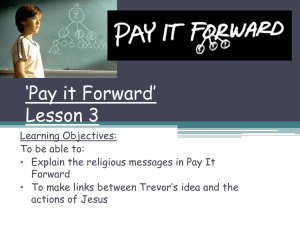The Return of the Prodigal Son: A Story of Homecoming
advertisement
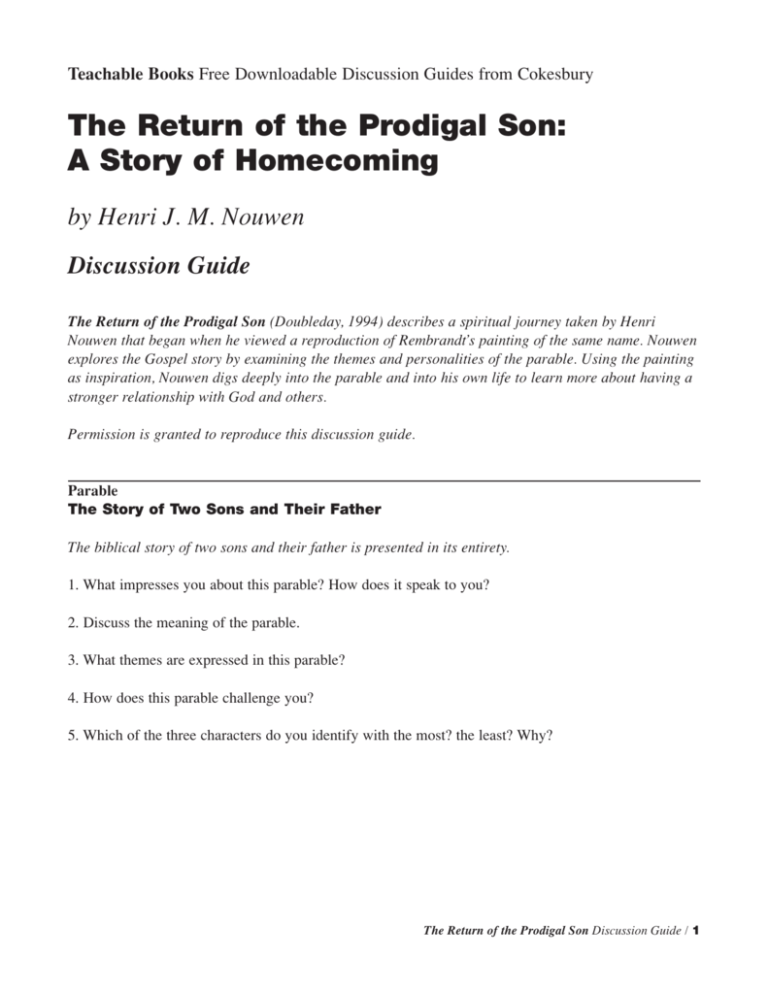
Teachable Books Free Downloadable Discussion Guides from Cokesbury The Return of the Prodigal Son: A Story of Homecoming by Henri J. M. Nouwen Discussion Guide The Return of the Prodigal Son (Doubleday, 1994) describes a spiritual journey taken by Henri Nouwen that began when he viewed a reproduction of Rembrandt’s painting of the same name. Nouwen explores the Gospel story by examining the themes and personalities of the parable. Using the painting as inspiration, Nouwen digs deeply into the parable and into his own life to learn more about having a stronger relationship with God and others. Permission is granted to reproduce this discussion guide. Parable The Story of Two Sons and Their Father The biblical story of two sons and their father is presented in its entirety. 1. What impresses you about this parable? How does it speak to you? 2. Discuss the meaning of the parable. 3. What themes are expressed in this parable? 4. How does this parable challenge you? 5. Which of the three characters do you identify with the most? the least? Why? The Return of the Prodigal Son Discussion Guide / 1 Prologue Encounter With a Painting Introduction The Younger Son, the Elder Son, and the Father These sections tell of Nouwen’s first encounter with the painting and introduce the three phases of his spiritual journey as he explores the parable. 1. Explain your interest in reading and discussing this book. What do you hope to gain from your reading? 2. Study the Rembrandt painting and discuss what you see and feel. 3. In what ways did the power of the Rembrandt painting become imprinted in Nouwen’s soul? 4. Why do you think Nouwen felt so close and connected to the painting? 5. What impressed you about Nouwen’s own story and situation as described in the prologue? Part I: The Younger Son Chapter 1 Rembrandt and the Younger Son This chapter provides some background about Rembrandt and the younger son. 1. What is known about Rembrandt’s painting of the prodigal son? 2. What does the painting reveal about Rembrandt? 3. In what ways was Rembrandt like the prodigal son? 4. How does the painting depict the prodigal son? 5. What observations does Nouwen make about the prodigal son? What does he observe about the father? The Return of the Prodigal Son Discussion Guide / 2 Chapter 2 The Younger Son Leaves This chapter explores a radical rejection by the prodigal son and why he was deaf to the voice of love. 1. Explain what it feels like to leave home. What issues are involved? 2. Why did the son leave? What expectations did he have when he left? 3. In what ways was the son’s leaving an offensive act? How was it a radical rejection? 4. What does Nouwen say about ways in which the parable expresses God’s love? 5. Have you ever felt like the prodigal son? Have you ever felt like the father? Explain the situations and your feelings. Chapter 3 The Younger Son’s Return This chapter explores what it means to be lost in life, wanting to return home. 1. How was the prodigal son changed by his experience? What lessons did he learn? 2. What did you learn about loneliness from reading this section? 3. Despite all his losses, what did the son still possess? 4. Explain why it is a challenge to receive God’s forgiveness. What keeps us clinging to sins? 5. What similarities does Nouwen see between Jesus and the prodigal son? Part II: The Elder Son Chapter 4 Rembrandt and the Elder Son This chapter shows how the elder son was also part of Rembrandt’s life experience. 1. How does Rembrandt portray the elder son? 2. What is the discrepancy between the parable and the painting? The Return of the Prodigal Son Discussion Guide / 3 3. Who do you believe is the man standing at the right in the painting and why? 4. What new insights about the painting and parable did you receive from reading this section? 5. What did both the younger son and the elder son have in common? Chapter 5 The Elder Son Leaves This chapter explores the actions and resentment of the elder son. 1. Why could Rembrandt’s painting also be called “The Parable of the Lost Sons”? 2. What similarities are there between you and the eldest son? Reflect on the “elder son” that lives within you. 3. Have you ever been in a situation where a source of joy for others was a source of resentment for you? Explain. 4. List and discuss reasons why the elder son was lost in resentment. 5. Do you agree with Nouwen that complaining is “self-perpetuating and counterproductive”? Explain your reasoning. Chapter 6 The Elder Son’s Return This chapter looks at the possible conversion of the elder son and at issues of gratitude and trust. 1. Why did Jesus leave this parable open-ended? 2. How did the father show his love to the eldest son? Were both sons treated the same by the father? 3. Explain how Jesus, according to Nouwen, represents both the elder son and younger son in the parable. 4. What roles do trust and gratitude play in our relationship with God and in dealing with the elder son within us? 5. What do you think happened to the elder son? Do you think he became willing to acknowledge that he was not better than his brother? The Return of the Prodigal Son Discussion Guide / 4 Part III: The Father Chapter 7 Rembrandt and the Father This chapter focuses on the feelings and actions of the father and how Rembrandt portrayed him. 1. How is this parable more about the father than the son? 2. How is the father depicted in the painting? What qualities are portrayed? 3. In what ways is the father like God our Father? 4. What do we learn about God from the father in this parable? 5. Discuss why the true center of the painting is the father’s hands. Chapter 8 The Father Welcomes Home This chapter examines what happened when the father first saw his younger son returning home. 1. How was the father more than just a great patriarch, according to Nouwen? Whom does the father represent? 2. What insights about God does Nouwen discover from Rembrandt’s portrayal of the father? 3. What do the parable and painting tell us about the father’s heart? What do they tell about the heart of God? 4. In what ways can you identify with Nouwen’s struggle to find God? Which of his spiritual struggles are also yours? 5. What does this parable have to say about love? Chapter 9 The Father Calls for a Celebration This chapter looks at the celebration for the son who has returned home. 1. What insights about God did you receive from the father’s treatment of his returning son? The Return of the Prodigal Son Discussion Guide / 5 2. Explain Nouwen’s observation that celebration belongs to God’s kingdom. 3. What do this parable and others tell us about reasons God rejoices? 4. In what way are celebrating and rejoicing real disciplines? 5. What is the significance of the feast the father prepared? Conclusion Becoming the Father Epilogue Living the Painting These sections provide a summary of Nouwen’s spiritual journey and challenge the reader to become more like the father in the parable. 1. How was Nouwen’s life changed by the parable and this painting? 2. How have you been changed or challenged by reading this book? 3. In what ways do you now view this parable differently? 4. How does Nouwen challenge us to be like the father? 5. What lessons about our compassion and God’s compassion are found in this parable? 6. In what ways does Jesus show us what true sonship is? 7. Explain why Nouwen believes that grief is a way to compassion. 8. What lessons about forgiveness and generosity are found in this parable? 9. What does the parable say about fatherhood? What does Nouwen say about it? 10. Look at the Rembrandt painting again. What do you see now that you did not see the first time? Copyright © 2003 Cokesbury www.Cokesbury.com/TeachableBooks Permission granted to reproduce this discussion guide The Return of the Prodigal Son Discussion Guide / 6

